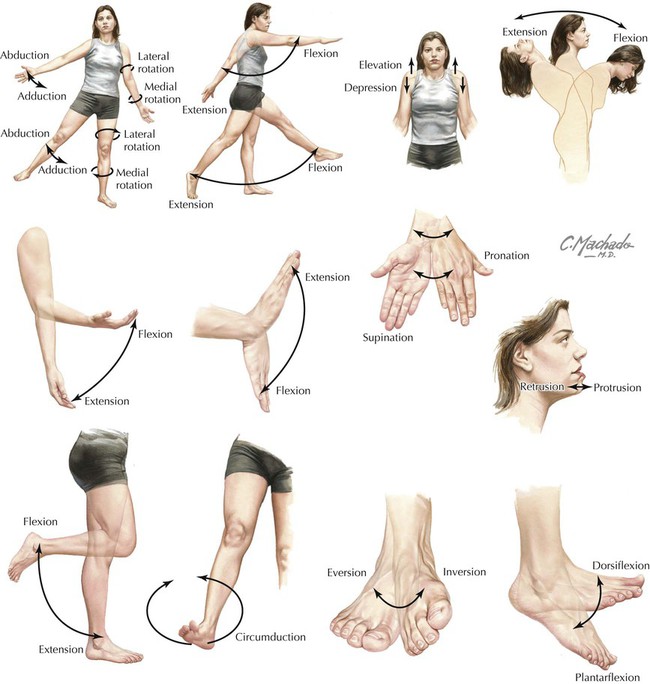Introduction to Anatomy
The human body is rarely static and its component parts, especially in the limbs, are dynamic entities anatomical language. Therefore has a special set of terms to denote the direction of movement of the various body parts. In the upper limb, flexion denotes a forward movement of the whole limb, or any part of the limb conversely backward movement of the limb or any part of the limb is referred to as an extension. When the upper limb is moved away from the vertical midline axis of the body that movement is referred to as abduction and movement of the limb towards the midline axis of the body denotes adduction.

Anatomical Movements
In certain joints there is so much versatility of movement that the individual parts can be moved about several different axes such multi axial joints best exemplified by the shoulder joint. the shoulder joint is so versatile that not only is it capable of flexion and extension and abduction and adduction but it is also capable of so-called internal rotation and external rotation.
Internal rotation is also known synonymously as medial rotation and external rotation. As lateral rotation internal rotation and external rotation at the shoulder joint can be demonstrated not only with the arm in the neutral position i.e. by the side of the body but also with the arm in abduction this with the arm in abduction is external rotation and this is internal rotation. A sequential combination of all of these movements in the shoulder joint is referred to as circumduction.
Moving distally down the limb you will observe that the forearm is capable of specialized rotatory movements and inward rotation of the forearm is referred to as pronation and returning to the forearm to the original position constitutes supination. If you should have any difficulty in remembering which is supination and which pronation simply remember the position of the thumb in each of these movements. In supination thumbs up's for super and in pronation thumbs down P for pants.
Easy moving further down the limb at the wrist joint the movements possible are a forward movement of the wrist joint which is flexion. A backward movement of the wrist joint which is extension and an addition to flexion and extension the wrist joint can also be deviated laterally which is called lateral or radial deviation or abduction or it can be moved in which is owner deviation or adduction in the hand the fingers are capable of a flexion. This is a forward bending of the fingers and straightening of the fingers which is extension in addition to flexion and extension.
It is also possible to move the fingers apart this constitutes abduction of the fingers an abduction of the fingers always relates to the long axis of the metacarpal bone of the middle finger thus movement away from the long axis of the middle finger. Metacarpal bone constitutes abduction and when the fingers are brought together which is to say brought towards the long axis of the middle finger metacarpal bone that movement constitutes adduction.
The thumb is the most flexible and versatile of the digits. It's capable of flexion extension abduction adduction and also a rotatory movement whereby the pulp of the thumb can be made to face the pulps of the other fingers and this inward rotate or E movement of the thumb is referred to as opposition the movements.
At the hip joint are flexion reflected in the forward movement of the thigh extension reflected in the backward movement of the thigh. Abduction, when the thigh is moved outward away from the median axis of the body and adduction of the hip joint reflected in the inward movement of the thigh. In addition to these four basic movements the hip joint is also capable of internal rotation and external rotation and either of these movements at the hip joint can be accomplished either with the limbs straight or with the knee flexed. A sequential combination of all of these movements at the hip joint constitutes circumduction of the hip moving further down the limb.
The knee joint is a modified hinge joint and the principal movements at the knee joint are flexion and extension. Now here extension of the knee joint is manifest as a forward movement of the leg and this apparent contradiction is explained by the rotation of the lower limb that happens during embryo-logical development so that the back of the leg is in fact the flexor surface of the leg and the front of the leg the extensor surface of the leg contrast this with the upper limb.
Now moving further down the lower limb we come to the ankle joint which is a uniaxial or hinge joint. The movements possible at the ankle joint are extension and flexion extension. At the ankle joint which is manifest as an upward movement of the foot is also referred to as dorsiflexion and flexion of the ankle joint manifest as a downward movement of the foot is referred to as plantar flexion named on plantar aponeurosis. Moving further along various small joints in the foot allow specialized movements of the foot an inward rotation of the foot whereby the medial border of the foot is elevated relative to the lateral border of the foot is referred to as inversion of the foot. The opposite movement where in the lateral border of the foot is elevated relative to the medial border of the foot constitutes eversion.
Finally the toes are capable of flexion and extension and to a considerable extent although not as impressively as in the hand the toes are also capable of abduction and adduction however in the foot abduction and adduction of the toes is related to the long axis of the metatarsal of the second tail.